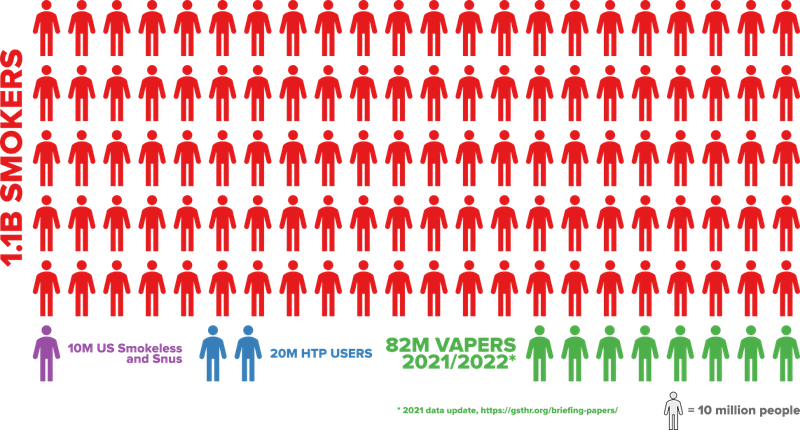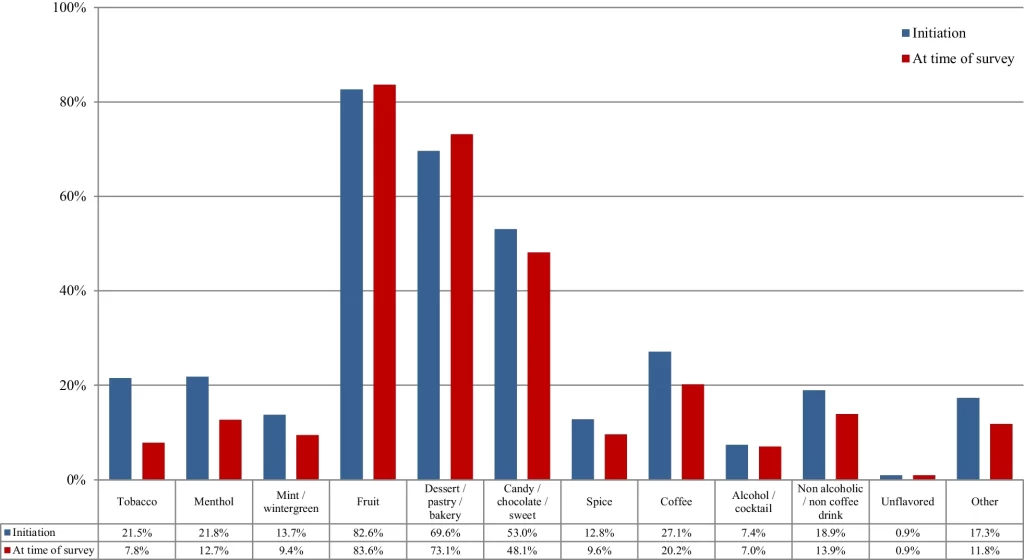In recent years, electronic cigarettes have positioned themselves at the forefront of the fight against smoking, offering hope but also generating debates, not always grounded in solid bases. To adequately address discussions about regulation, it is fundamental to understand their impact on smoking cessation based on scientific evidence and recognize the variety of flavors they offer as one of their strengths.
Although electronic cigarettes are not free from risks, significant entities indicate that they are a considerably safer alternative than traditional cigarettes, loaded with thousands of harmful chemicals originating from tobacco combustion.
Since their emergence two decades ago, these devices have become a beacon of hope for those struggling with tobacco addiction. Over 100 million people who have left behind the unpleasant aroma and taste of tobacco for a wide range of olfactory and gustatory experiences testify that this change is much more than a simple habit modification. It is, in essence, a sensory journey towards a less harmful existence.
According to the Global State of Tobacco Harm Reduction (GSTHR) report, it was estimated that around 82 million people worldwide abandoned cigarettes for vaping in 2021. Despite these numbers, considerable resistance is observed in the United States from certain authorities reluctant to the benefits of nicotine vaping, who have implemented flavor bans on these harm reduction devices.

The flavor ban has led users to resume smoking. Examples of this emerge from various regions of the United States. In San Francisco, California, the ban led to a notable increase in smoking among teenagers, as documented by Addiction Behavior reports and the Journal of the American Medical Association (JAMA).
Similarly, an increase in cigarette sales was registered in Washington, Rhode Island, New York, Massachusetts, and Nova Scotia, suggesting an adverse response to the flavor ban. These events underline the complexity of nicotine product regulation and the need for a balanced approach that considers harm reduction efforts and consumer preferences.
This attitude, far from being protective, seems to punish pleasure and further complicate the already difficult path towards tobacco cessation, even when a smoker opts for flavored nicotine vaping as their favorite dessert. Paradoxically, the biggest obstacles to quitting smoking are being raised by those entities that should be facilitating this process, thus evidencing a set of misinformed policies.
Statistics and Flavors: A Look at Vapers’ Preferences
The role of flavors in electronic cigarettes as a tool to quit smoking has been the center of a recent study published in the Harm Reduction Journal. A multidisciplinary team of researchers led by Konstantinos Farsalinos, linked to institutions such as CoEHAR, the University of West Attica, and the University of Patras in Greece, conducted an exhaustive analysis of the consumption habits of flavored electronic cigarettes.
For this, they studied about 70,000 adult vapers in the United States, revealing results about the positive influence these flavors have in transitioning from traditional smoking. The popularity of fruity, dessert, and chocolate flavors in electronic cigarettes not only highlights the preferences of vapers but also, according to the study, plays an essential role in preventing relapses into traditional tobacco consumption.
This aromatic landscape is at odds with current political stances. Organizations like the Framework Convention on Tobacco Control (FCTC) and several governments are recommending a total ban on flavors other than tobacco, arguing that they are a magnet for younger generations and their initiation into nicotine. However, the question arises: is this decision based on a deep and detailed understanding, or is it simply a hasty response to superficial perceptions?
The figures speak for themselves. Statistics reveal a clear trend in flavor preferences among vapers, especially among those seeking to move away from traditional tobacco consumption. Fruity flavors lead the list, being the initial choice of 82.8% of users. Dessert and bakery flavors follow closely, with a preference of 68.6%. The sweet flavor of chocolate is chosen by more than half, with 52.2%.

On the other hand, tobacco-imitating flavors seem less attractive, with just 20.8% of respondents opting for them. This number decreases even more among those who have never leaned toward traditional cigarettes. When quitting tobacco, fruity and dessert flavors maintain their popularity, with percentages of 83.3% and 68.0%, respectively. These figures undoubtedly present a panorama that should be considered when discussing the regulation of electronic cigarettes.
“This is the largest survey ever conducted on the use of electronic cigarettes in terms of sample size,” explains Dr. Konstantinos Farsalinos, the study’s author. “The most interesting finding is that when a smoker decides to quit smoking using electronic risk-modified tools, they lean towards flavors other than tobacco, with a clear preference for fruit, dessert, and chocolate flavors. Therefore, we can deduce that these specific flavors are more useful for those who want to quit smoking or avoid relapses.”
Towards an Informed Approach
From the study, it is clear that flavors play a fundamental role for many vapers in their journey to quit tobacco consumption. These results question the idea that banning flavors in electronic cigarettes is an effective solution to combat smoking or protect young people. On the contrary, it could be an obstacle that prevents many smokers from considering vaping as a viable alternative to reduce or eliminate their tobacco consumption.
Given the evidence, regulatory policies that should be based on data seem to be grounded in misconceptions. While it is essential to protect young people and prevent them from starting vaping, from a public health standpoint, it is equally crucial to ensure that those seeking an alternative to traditional tobacco have access to tools that facilitate that transition.
Another important study published in the New England Journal of Medicine found that electronic cigarettes are almost twice as effective for quitting smoking compared to conventional nicotine replacement products such as patches or chewing gum.
A total ban on flavors could limit the effectiveness of vaping as a harm reduction method and ultimately do more harm than good. The recommendation to ban flavors seems to ignore emerging evidence suggesting that these flavors are, in fact, a valuable tool for those seeking to quit smoking.
A more nuanced approach is needed that addresses both legitimate concerns about vaping’s appeal to young people and the potential of flavored electronic cigarettes to aid in smoking cessation. Recent research highlights a crucial reality: in the rush to address smoking and vaping among young people, the broader picture, especially regarding those adults seeking to leave traditional cigarettes, may have been overlooked.
In this delicate balance between public health and political decisions, careful analysis is essential, considering all dimensions of the problem before implementing hasty regulations. Banning flavors in electronic cigarettes without considering their potential for harm reduction for adults is a reductionist approach. Instead of rushed solutions, we need informed responses focusing on real and lasting public health benefits.
Policymakers must immerse themselves in the evidence and understand the complexities of vaping and its relationship with smoking cessation to ensure that proposed interventions are truly beneficial and do not generate collateral damage. The fight against tobacco addiction is multifaceted and requires an equally diverse and well-informed approach.
“It is of utmost importance to identify factors that can promote the transition to tar-free products and accelerate the eradication of smoking among adults. One of these factors is the inclusion of diverse flavors. In this context, fruit flavors, desserts, cakes, bakery items, candies, chocolate, and sweets emerge as key elements that can help adult smokers in their cessation efforts and contribute to reducing relapse rates. Although more prospective studies are required, this research presents compelling evidence that public health policies should refrain from adopting overly restrictive measures regarding flavors in electronic cigarettes,” explains Professor Riccardo Polosa, founder of CoEHAR.

